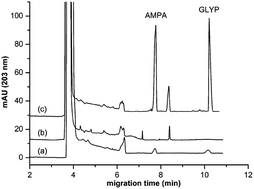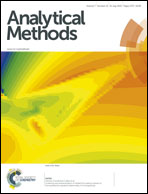Magnetic solid phase extraction of glyphosate and aminomethylphosphonic acid in river water using Ti4+-immobilized Fe3O4 nanoparticles by capillary electrophoresis
Abstract
The residual glyphosate (GLYP) in the environment is harmful to human health. Monitoring GLYP and its major metabolite aminomethylphosphonic acid (AMPA) in a complicated matrix is an important analytical task. Based on the affinity of phosphate groups to metal ions, iron oxide nanoparticles immobilized with Ti4+ using polydopamine (PDA) as bridging molecules (Fe3O4@PDA-Ti4+ NPs) were employed to develop a magnetic solid phase extraction (mSPE) method for GLYP and AMPA by electrostatic interaction. After extraction with Fe3O4@PDA-Ti4+ NPs and elution for 5 min, the purified and enriched analytes were derivatized, prior to CE with diode array UV detection. Relying on the coupled mSPE-CE method, the detection limits were 0.4 ng mL−1 for GLYP and AMPA. The present method was employed to monitor GLYP and AMPA in a Roundup® sample and river water sample, revealing its good possibilities for applicability. Herein, by virtue of the immobilized metal affinity extraction (IMAE), the coupled mSPE-CE method would be effective, easy to operate and applicable for analyzing herbicides in environmental samples.


 Please wait while we load your content...
Please wait while we load your content...